It’s understandable why so many fishkeeping enthusiasts want to have bamboo within their aquascape. But there’s a flaming debate on whether you can put bamboo in a fish tank and if it’s safe for your fish. Yet this plant looks just mesmerizing, giving that impression of a small Chinese forest. But does it want to be in your aquarium? If so, how to put it in there, would it sink?

The concept of a bamboo plant that’s submerged in fish tank water completely does raise some questions.
I found the answers to all of these.
The truth about having bamboo in a fish tank setup

If you’ve been in the hobby for long enough, you’ve inevitably run into the claim that bamboo is an aquatic plant.
You’ve probably also watched someone showcasing their bamboo aquarium online.
You may have even seen one with your own eyes.
What you may have seen or heard, however, simply isn’t true.
Or at least not entirely.
Clarification on the common misconception about using bamboo in an aquarium:
True bamboo (Bambusoideae subfamily) is not an aquatic plant. It will immediately start to rot when introduced to a fish tank. This will foul the water and induce a spike in ammonia levels, which can be lethal to fish unless promptly lowered. Thus, you can’t put true bamboo in your aquarium.
There is a plant that strongly resembles true bamboo and WILL survive in your tank, however.

Dracaena Sanderiana, commonly known as lucky bamboo can survive partially or fully submerged in water.
Unlike the water averse true bamboo, lucky bamboo has adapted to survive floodings.
So with proper care and sufficient nutrients, it can be safely introduced to an aquarium.
Author’s note: Lucky bamboo is not an aquatic plant as well.
However, its origins and survival mechanisms allow it to live in water for a prolonged period of time.
This period can be extended greatly – up to years.
Despite having a similar appearance to true bamboo, lucky bamboo actually belongs to an entirely different taxonomic order.
True bamboo belongs to the Poales order whereas lucky bamboo is part of the Asparagales order.
This essentially means that lucky bamboo isn’t even a type of bamboo.
Apart from their environmental preferences, both plants can be distinguished from one another by their stem.
Lucky bamboo has a fleshy stalk which helps it tolerate higher humidity levels.
In contrast, true bamboo has a hollow, yet extremely hard stalk, which is why it was often used as a construction material in the past.
The only feature these two plants share in common is that they both grow in a columnar fashion, hence the similarity in their appearance.
The honest truth about growing lucky bamboo submerged in water
This is one of the most controversial topics I’ve found on and offline.
I, myself, have switched between team “fully submerged” and “leaves above the water” more than once.
After reading tons and discussing it with successful and unsuccessful users I finally came to the conclusion that I’ll just have to try it myself.
This plant was simply too good-looking in an aquarium, so I thought it’s worth the experiment.
Here’s what happened:
It’s true. You can grow lucky bamboo underwater as long as it is fresh water. It does not rot and the leaves keep growing.
Also, other experienced fish keepers and I agree that this type of plant is beneficial for Betta aquariums.
The benefits come from the fact that the leaf coverage of the plant mimics the natural habitat of Betta fish.
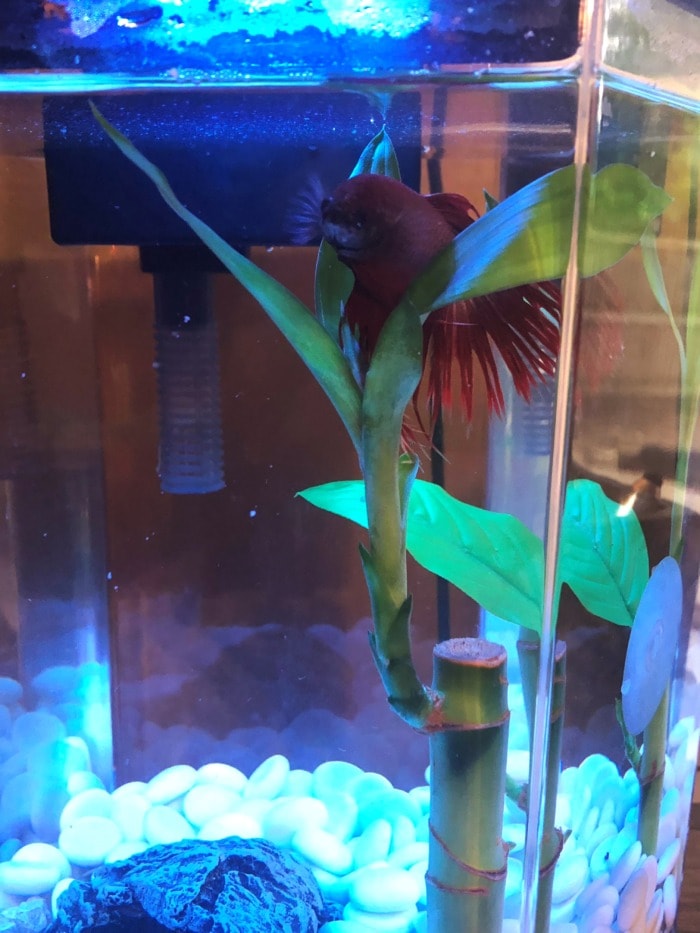
Anyway, there’s a secret to keeping lucky bamboo happy and thriving.
Actually a couple of secrets.
I will share them with you and put an end to this dispute once and for all.
Here’s what you need to do to grow lucky bamboo fully submerged in water:
- Supply it with sufficient carbon dioxide. It has been my experience that CO2 injections really do help, and the plant will grow slower without them.
You can also use some sort of fertilizer for aquatic plants. I’m using Seachem Flourish for the purpose and I’m really happy with it.
Simply follow the instructions and put in a full cap everyday or every other day. You can check out Flourish over here at Amazon.
Using Flourish is not necessary, but I feel like it helps, especially when your bamboo plant is still small.
- Plant it deeply. This way you limit the roots from spreading above your substrate and becoming a questionable snack for a curious fish.
If you plan to or already have reasonably small fish then they won’t really pose a threat to your bamboo. However, a bulkier fish like the voracious goldfish…
Typically, omnivorous fish such as goldfish would try to demolish the roots of your lucky bamboo if they protrude from the substrate. If you own a Goldfish tank I recommend a different set of plants.
Any fish that chews on the roots could stress the plant. Also, creatures who like to bury themselves in the aquarium’s substrate like eels could unintentionally mess up the bamboo’s stability. However, bottom dwellers that don’t violently interact with the substrate, such as the smallest of plecos and shark-like fish will not be a problem for the bamboo plant and vice versa.
Anyway, deeper planting really helps with the stability of the stem and its positioning.
The way I recommend putting your lucky bamboo in the fish tank is by burying it in the substrate at a depth of between 3 and 4 inches.
Author’s note: As long as its roots are submerged in water, Lucky bamboo will thrive.
Anyhow, for some quality options regarding nutrient-rich soil substrates for planted tanks, I put together a comprehensive guide that you can visit here. However, nutrient-rich substrates are not necessarily needed for a thriving bamboo plant.
- Provide it with low to medium lighting. Lucky bamboo needs low lighting by definition.
It originates from the tropical forests of Cameroon where taller broad-leafed plants would cast shadows over it.
In response, it had to adapt its light requirements to survive.
Direct sunlight will burn the plant’s leaves and they will turn yellow, which is a good sign to turn down or redirect the lights. If you’re new to aquarium lighting and don’t really know what fixture will best suit a low light-requiring plant, I suggest that you skim through this guide.
Busting some lucky bamboo myths
1. It will secrete toxic compounds in the water – That will only happen if you put real bamboo in your aquarium and not Dracaena.
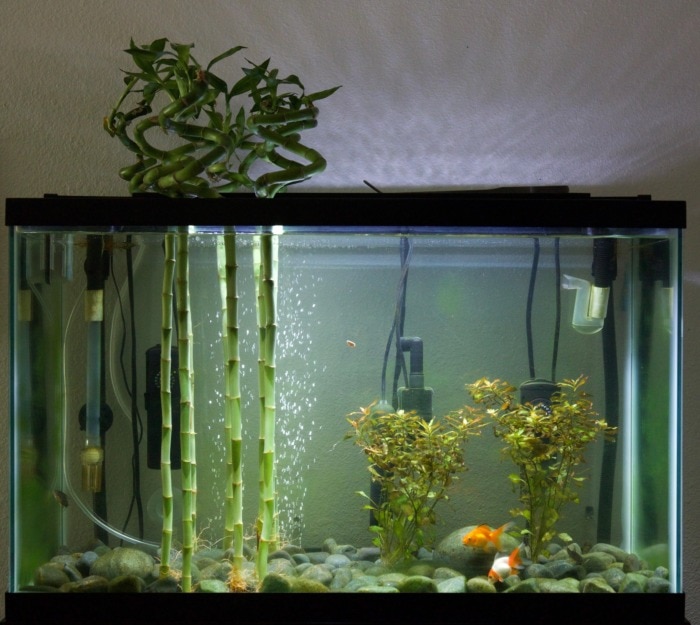
Real bamboo belongs to a completely different family of plants and it will rot when submerged in water.
Lucky bamboo is not at all toxic to your fish. If you don’t want to contaminate your water, make sure you’re actually getting Dracaena Sanderiana and not something else.
Author’s note: Some people advocate using dried real bamboo in the fish tank.
In that case, you’d need to boil the sticks for at least 30 minutes.
There might be some dormant mold on it (in the form of little black spots), which you wouldn’t want to introduce to your aquarium.
Make sure they are naturally grown – pesticides are dangerous to your fish.
Here comes the tricky part though: You’d need to coat it with a clear matte, that’s based on acrylic resin.
This is done to prevent water from entering the wood, causing it to rot.
However, I am not a fan of the idea, because you’d have to coat it inside out to completely seal it.
If the bamboo sticks are, say, 1/3 inches in diameter it will be really hard to fully cover the inside.
If you do, by any chance, decide this is your method, sink your sealed bamboo in crystal clear water for at least 24 hours after the treatment.
After that, check if there has been any contamination during that time.
It would be a clever move to test this water before and after the soak to see if there were suspicious movements in its parameters.
2. You won’t be able to fertilize it because most aquatic plants take up nutrients through their leaves – Yes, the plant won’t take its nutrients through the leaves, but in actuality, that won’t be needed at all.
Fish tank water is heaven for this plant even when its roots are deeply buried in the substrate.
Aquarium water has tons of nutrients, including magical fish waste.
This on its own could be enough, but I like supplementing it with a light liquid fertilizer that contains trace elements. The beneficial bacteria in the tank will take care of the rest.
If your tank is properly cycled (a link to the guide I wrote on how to do that in less than two weeks) your beneficial bacteria will convert the ammonia into tasty nitrates. Lucky bamboo LOVES eating nitrate.
In fact, one of the greatest benefits of having bamboo in your aquarium is that it would keep the nitrate levels of your tank in check.
And keeping nitrate levels in check is important because having too much of them for too long in the aquarium could damage a fish’s swimbladder, making it lose control over its buoyancy.
On top of that, controlling nitrate in the water will keep all the different types of algae at bay.
3. The leaves need to remain above the water – This is not necessary, but there’s nothing wrong with it either.
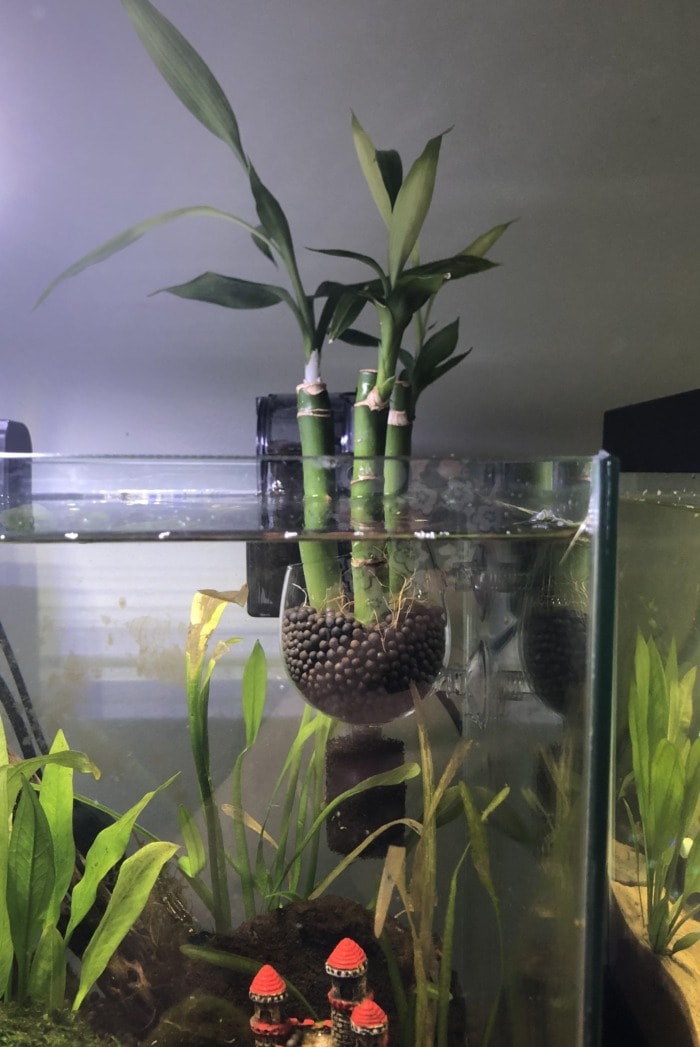
The plant will thrive with its leaves out of the water and if you think it looks better on your current aquascape setup – go wild.
4. You need to grow it in your filter – I’ve noticed that it’s sort of trendy for people to grow lucky bamboo in their filters.
That’s completely fine, but it’s not exactly needed either.
If you choose to do so, you may find out that the plant’s root system will eventually outgrow your filter’s available space.
If you want lucky bamboo as decor, it’s best to just plant it inside your tank, it will still use up plenty of nitrates.
Best place to get yours
Your local pet store will have them for sale, that’s for sure.
Asian supermarkets will have them as well but, perhaps, a little pricier.
However, I found that Amazon has the best collective price on them in general, as long as you’re willing to wait for the delivery (which in my humble opinion is totally worth it). Browse around in their store a little and find the deal that suits you best.
If your aquarium is taller I suggest you look up the spiral lucky bamboo.
My Conclusion
Lucky bamboo is a great aquarium plant that can be used to create an exotic aesthetic, clear water or simply add a twist to your setup.
As someone who’s a huge fan of Asian culture, I whole-heartedly recommend it to other kindred spirits.
There’s no better way to transfer a piece of paradise to your home than making your very own underwater bamboo forest.


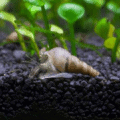


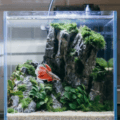






40 thoughts on “Truths & Myths About Lucky Bamboo in the Aquarium”